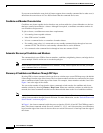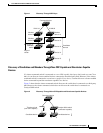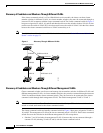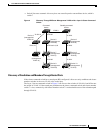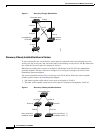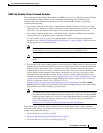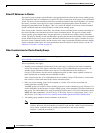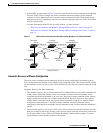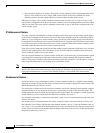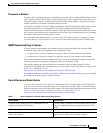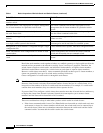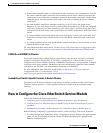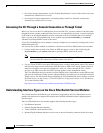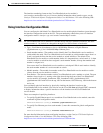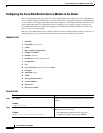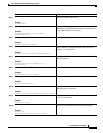
Cisco EtherSwitch Service Modules Feature Guide
Information About the Cisco EtherSwitch Service Modules
30
Cisco IOS Release 12.2(25)SEC
• This limitation applies to all clusters: If the active cluster command switch fails and becomes active
again, it does not discover any Catalyst 1900, Catalyst 2820, and Catalyst 2916M XL cluster
member switches. You must again add these cluster member switches to the cluster.
When the previously active cluster command switch resumes its active role, it receives a copy of the
latest cluster configuration from the active cluster command switch, including members that were added
while it was down. The active cluster command switch sends a copy of the cluster configuration to the
cluster standby group.
IP Addresses in Clusters
You must assign IP information to a cluster command switch. You can assign more than one IP address
to the cluster command switch, and you can access the cluster through any of the command-switch IP
addresses. If you configure a cluster standby group, you must use the standby-group virtual IP address
to manage the cluster from the active cluster command switch. Using the virtual IP address ensures that
you retain connectivity to the cluster if the active cluster command switch fails and that a standby cluster
command switch becomes the active cluster command switch.
If the active cluster command switch fails and the standby cluster command switch takes over, you must
either use the standby-group virtual IP address or any of the IP addresses available on the new active
cluster command switch to access the cluster.
You can assign an IP address to a cluster-capable switch, but it is not necessary. A cluster member switch
is managed and communicates with other cluster member switches through the command-switch IP
address. If the cluster member switch leaves the cluster and it does not have its own IP address, you then
must assign IP information to it to manage it as a standalone switch.
Note Changing the cluster command switch IP address ends your Network Assistant session on the switch.
Restart your Network Assistant session by entering the new IP address in the browser Location field
(Netscape Communicator) or Address field (Internet Explorer), as described in the release notes.
Hostnames in Clusters
You do not need to assign a hostname to either a cluster command switch or an eligible cluster member.
However, a hostname assigned to the cluster command switch can help to identify the switch cluster. The
default hostname for the switch is Switch.
If a switch joins a cluster and it does not have a hostname, the cluster command switch appends a unique
member number to its own hostname and assigns it sequentially as each switch joins the cluster. The
number means the order in which the switch was added to the cluster. For example, a cluster command
switch named eng-cluster could name the fifth cluster member eng-cluster-5.
If a switch has a hostname, it retains that name when it joins a cluster. It retains that hostname even after
it leaves the cluster.
If a switch received its hostname from the cluster command switch, was removed from a cluster, was
then added to a new cluster, and kept the same member number (such as 5), the old hostname (such as
eng-cluster-5) is overwritten with the hostname of the cluster command switch in the new cluster (such
as mkg-cluster-5). If the switch member number changes in the new cluster (such as 3), the switch retains
the previous name (eng-cluster-5).



